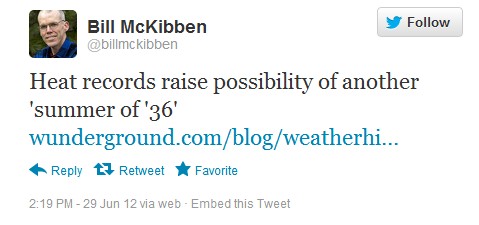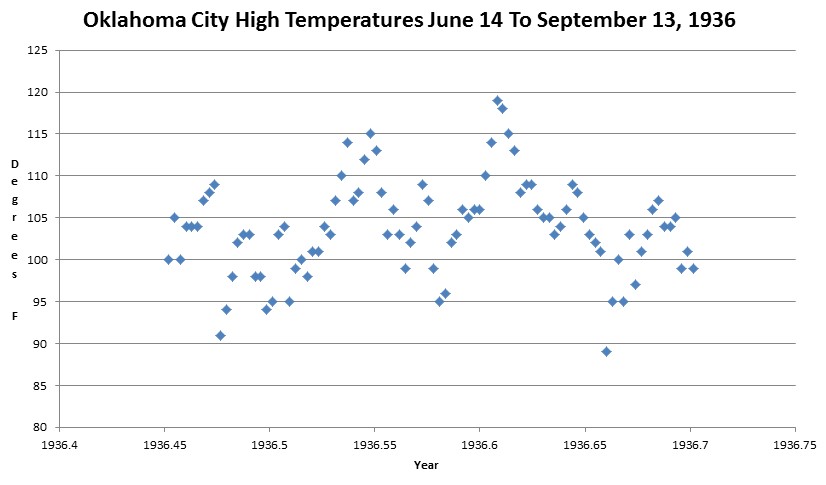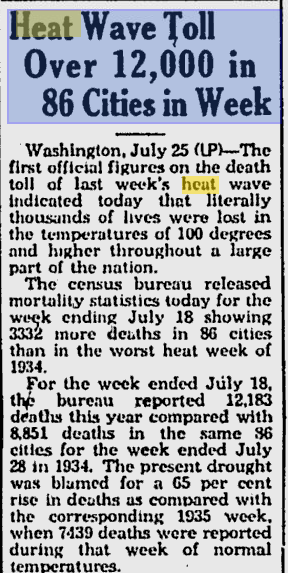Twitter / billmckibben: Heat records raise possibi
People making comparisons to the heatwave of 1936 have absolutely no idea what they are talking about. From June 14 to September 13 1936, high temperatures in Oklahoma City averaged 104 degrees.
Seventy-two out of ninety-two days were over 100F. Eleven days were over 110F. Four days were over 115F
By contrast, since June 13 2012, temperatures have averaged 94F – eight degrees cooler than the same period in 1936. Holocaust deniers attempt to rewrite the history of the 1930s, and thus have much in common with Hansen et. al.
http://news.google.com/newspapers
h/t to Marc Morano







I pretty sure they can adjust that away if we just look the other way for a minute.
No suyts, they’ll look us straight in the eye as they’re doing it and will continue to do so until we vote in politicians that will not only make them stop but will bring felony evidence tampering charges against them.
I sincerely hope that starts in Jan 2013.
But you are only looking at OKC, what about the rest of the Country.
http://www.cbsnews.com/8301-205_162-57489165/july-heat-broke-1930s-dust-bowl-record/
August 8, 2012
This probably comes as no surprise: Federal scientists say July was the hottest month ever recorded in the Lower 48 states, breaking a record set during the Dust Bowl of the 1930s.
And even less a surprise: The U.S. this year keeps setting records for weather extremes, based on the precise calculations that include drought, heavy rainfall, unusual temperatures, and storms.
The average temperature last month was 77.6 degrees. That breaks the old record from July 1936 by 0.2 degree, according to the National Oceanic and Atmospheric Administration. Records go back to 1895.
“It’s a pretty significant increase over the last record,” said climate scientist Jake Crouch of NOAA’s National Climatic Data Center in Asheville, N.C. In the past, skeptics of global warming have pointed to the Dust Bowl to argue that recent heat isn’t unprecedented. But Crouch said this shows that the current year “is out and beyond those Dust Bowl years. We’re rivaling and beating them consistently from month to month.”
Three of the nation’s five hottest months on record have been recent Julys: This year, 2011 and 2006. Julys in 1936 and 1934 round out the top five.
Last month also was 3.3 degrees warmer than the 20th century average for July.
Thirty-two states had months that were among their 10 warmest Julys, but only one, Virginia, had the hottest July on record. Crouch said that’s a bit unusual, but that it shows the breadth of the heat and associated drought.
The first seven months of 2012 were the warmest on record for the nation. And August 2011 through July this year was the warmest 12-month period on record, just beating out the July 2011-June 2012 time period
“The fact that the first seven months of the year are the hottest on record is much more impressive from a climate standpoint, and highlights the fact that there is more than just natural variability playing a role: Global warming from human activities has reared its head in a way that can only be a major warning for the future.”
You are looking at severely tampered with data. I am looking at the actual measured data.
http://stevengoddard.wordpress.com/2012/08/11/hiding-the-decline-the-man-made-hockey-stick/
http://stevengoddard.wordpress.com/2012/08/16/94-of-midwest-record-july-maximum-temperatures-were-set-below-350-ppm-co2/
http://stevengoddard.wordpress.com/2012/08/16/the-1930s-were-much-much-hotter-in-the-midwest/